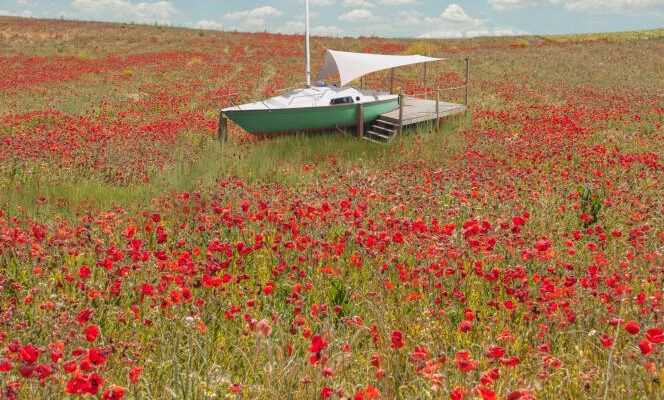In this room, even the accounting meetings take place in a perky atmosphere. The soothing, even euphoric effect of the cocoon, symbol of escape. It is a 10-meter trimaran which serves as an annex, in the garden of Station-C, a workspace shared by fourteen companies, in Saint-Barthélemy-d’Anjou (Maine-et-Loire). Between the floats, the widened hull accommodates a terrace. A table for eight people has found a place inside, a giant screen at the back, a small bar at the entrance, of this sailboat which cut through the waves for twenty-five years.
“ We had considered a wood extension of Station-C, traces Yvain Bignonet, who is the founder. But since we bought this boat, all the companies present are proud to have avoided the burial of 4 tons of waste. “ Entrepreneur in the nautical industry, Mr. Bignonet speaks as a specialist about “The disaster to come that is the lack of a yachting recycling channel”. ” We inherit forty years of industrial plastic production! “ At the Paris Boat Show, two years ago, he found a rough solution in the person of Didier Toqué, co-founder of the Bathô integration shipyard. Very close to Nantes, in Rezé, old sailing ships are reworked to set sail for a second life, on land, escaping scrapping, then burial or incineration. A virtuous re-employment which earned the company, at the end of 2020, the National Social and Solidarity Economy Prize, ecological transition category.
“Unusual shipyard! “
On the azure blue pediment, the inscription “Bathô, unusual shipyard! “ looms at the end of a parking lot where the boats are aligned. Others still pile up further on, partially dismembered. Under the workshop shed, young and old alike are trained in working with wood, metal and composite materials. The cast iron keel is removed, the boat is placed on the ground on a wooden support. The mast, shortened but preserved, supports a shade cloth floating in the wind, like the old sails. The hull, the deck, the portholes, the fittings (these accessories used for maneuvers), the strapping protecting the perimeter, the interior woodwork and cushions, generally in poor condition, everything is redone. The bar becomes the front door, the engine box, a storage.
“Naval architects have exploited every nook and cranny with mad intelligence. From 6.50 meters long, there are at least four beds, shows M. Toqué. At the customer’s place, we build a final wooden mooring pontoon, which serves as a terrace. A fishing boat wheelhouse can accommodate a dry toilet and a solar shower. We adapt to everyone’s wishes. And we leave little stories on board. »Navigation testimonials from the former owners, barometer and life jacket, adventure books, postcards from such a Breton village in 1979… Baby-boomers-sur-mer atmosphere.
You have 71.92% of this article left to read. The rest is for subscribers only.
